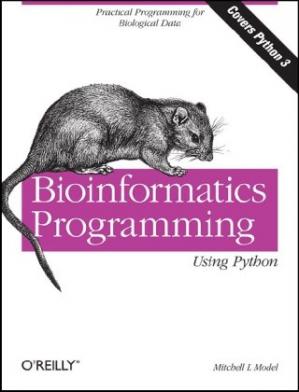
与Perl相比,Python作为脚本语言在生物信息学领域的应用相当滞后,尽管它最近得到了一些时机。如果你在几年前阅读生物信息学工程师或科学家职位的工作描述,你几乎看不到Python被提及,甚至是作为 "不错的可选技能"。其中一个原因可能是缺乏好的Python入门级生物信息学书籍,所以一般来说,认为Python是生物信息学的好选择的人比较少。O Reilly公司的《生物信息学Perl入门》一书出版于2001年。近十年后,我们终于得到了Mitchell Model的《生物信息学编程使用Python》一书,填补了这一空白。
Comparing to Perl, Python has a quite lagged adoption as the scripting language of choice in the field of bioinformatics, although it is getting some moment recently. If you read job descriptions for bioinformatics engineer or scientist positions a few year back, you barely saw Python mentioned, even as "nice to have optional skill". One of the reasons is probably lacking of good introductory level bioinformatics books in Python so there are, in general, less people thinking Python as a good choice for bioinformatics. The book "Beginning Perl for Bioinformatics" from O Reilly was published in 2001. Almost one decade later, we finally get the book "Bioinformatics Programming Using Python" from Mitchell Model to fill the gap.
When I first skimmed the book "Bioinformatics Programming Using Python", I got the impression that this book was more like "learning python using bioinformatics as examples" and felt a little bit disappointed as I was hoping for more advanced content. However, once I went through the book, reading the preface and everything else chapter by chapter, I understood the main target audiences that author had in mind and I thought the author did a great job in fulfilling the main purpose.
In modern biological research, scientists can easily generate large amount of data where Excel spreadsheets that most bench scientists use to process limiting amount of data is no longer an option. I personally believe that the new generation of biologists will have to learn how to process and manage large amount inhomogeneous data to make new discovery out of it. This requires general computational skill beyond just knowing how to use some special purpose applications that some software vendor can provide. The book gives good introduction about practical computational skills using Python to process bioinformatics data. The book is very well organized for a newbie who just wants to start to process the raw data their own and get into a process of learning-by-doing to become a Python programmer.
The book starts with an introduction on the primitive data types in Python and moves toward the flow controls and collection data type with emphasis on, not surprisingly, string processing and file parsing, two of most common tasks in bioinformatics. Then, the author introduces the object-oriented programming in Python. I think a beginner will also like those code templates for different patterns of data processing task in Chapter 4. They summarize the usual flow structure for common tasks very well.
After giving the basic concept of programming with Python, the author focuses on other utilities which are very useful for day-to-day work for gathering, extracting, and processing data from different data sources. For example, the author discusses about how to explore and organize files with Python in the OS level, using regular expression for extracting complicated text data file, XML processing, web programming for fetching online biological data and sharing data with a simple web server, and, of course, how to program Python to interact with a database. The deep knowledge of all of these topics might deserve their own books. The author does a good job to cover all these topics in a concise way. This will help people to know what can be done very easily with Python and, if they want, to learn any of those topic more from other resources. The final touch of the book is on structured graphics. This is very wise choice since the destiny of most of bioinformatics data is very likely to be some graphs used in presentations and for publishing. Again, there are many other Python packages can help scientists to generate nice graph, but the author focuses on one or two of them to show the readers how to do general some graphs with them and the reader might be able to learn something else from there.
One thing I hope the author can also cover, at least at a beginner level, is the numerical and statistical aspect in bioinformatics computing with Python. For example, Numpy or Scipy are very useful for processing large amount of data, generating statistics and evaluating significance of the results. They are very useful especially for processing large amount data where the native Python objects are no longer efficient enough. The numerical computation aspect in bioinformatics is basically lacking in the book. The other thing that might be desirable for such a book is to show that Python is a great tool for prototyping some algorithms in bioinformatics. This is probably my own personal bias, but I do think it is nice to show some basic bioinformatics algorithm implementations in python. This will help the readers to understand a little bit more about some of the common algorithms used in the field and to get a taste on a little bit more advanced programming.
Overall, I will not hesitate to recommend this book to any one who will like to start to process biological data on their own with Python. Moreover, it can actually serve as a good introductory book to Python regardless the main focus on bioinformatics examples. The book covers most day-to-day basic bioinformatics tasks and shows Python is a great tool for those tasks. I think a little more advanced topics, especially on basic numerical and statistical computation in the book, will also help the target audiences. Unfortunately, none of that topic is mentioned in the book. That has been said, even if you are an experienced python programmer in bioinformatics, the book's focus on Python 3 and a lot of useful templates might serve well as a quick reference if you are looking for something you do not have direct experience before.













